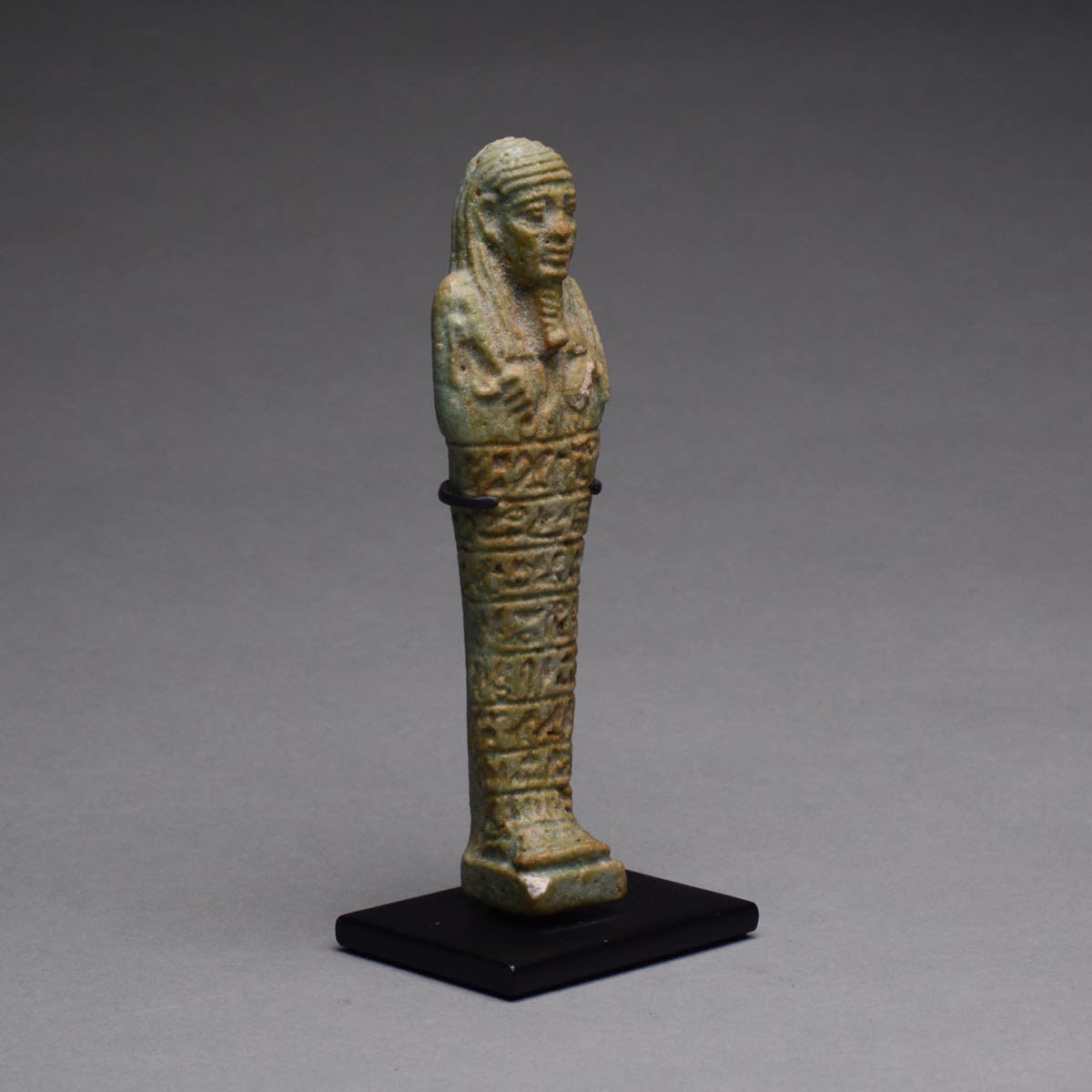Faience Ushabti of the 26th Dynasty, 664 BCE - 525 CE
Faience
14.3 x 4.4 cm
5 5/8 x 1 3/4 in
5 5/8 x 1 3/4 in
PF.1130
Further images
Ushabti can be translated as “the answerer,” a term directly related to its function in the afterlife. Initially, only one ushabti was interred with the deceased. When the call came...
Ushabti can be translated as “the answerer,” a term directly related to its function in the afterlife. Initially, only one ushabti was interred with the deceased. When the call came for the departed soul to “work,” the ushabti would take its place acting as a surrogate and leaving the soul in peace. Later, in the New Kingdom, hundreds of ushabti were part of the funerary accouterments and served as slaves, much as their human counterparts did in the real world. The number of figures depended on the individual's wealth. Ready for hard work, this elegant ushabti holds two hoes, one in each hand. Embodied in its form is the essence of ancient Egypt, combining the sacred element in the divine mummy shape, and the rural aspect of labor in the fields. Blue and green faience were the most prized and valuable, considered worthy even for kings. The lovely green of the stone reminds us of the verdant fields watered by the Nile, flowing eternally, as does the life force that nourishes all living things.
Perhaps no single object epitomizes the spirit of ancient Egypt better than the ushabti. Shaped like a divine mummy, the ushabti evokes the magical side of Egyptian belief in an afterlife. The two hoes clutched in the hands and the basket carried on the back recall the rural, agrarian culture of the land. The word ushabti (supplanting the older term shawabti) literally means "the answerer." The function of these little figures is described in Chapter VI of the Book of the Dead: "O this Ushabti! If (the deceased) is called upon to do hard labor in the hereafter, say thou: I am here." The ushabti was expected to answer the call to work in place of the deceased, and this passage was frequently inscribed on the figures themselves. Originally, a single ushabti was placed in any given tomb. But by the New Kingdom the statues had come to be regarded as servants and slaves for the deceased, rather than as a substitute. Many have been found buried together, along with an overseer figure. In the course of Egyptian history, ushabti were created from wood, stone, metal and faience. In the cultural renaissance of the XXVIth Dynasty (Saite period), a green faience, the color of the Nile and evocative of the verdant landscape in springtime, was particularly popular. To look upon an ushabti is to come face to face with the mystery and magic of Egypt itself.
Perhaps no single object epitomizes the spirit of ancient Egypt better than the ushabti. Shaped like a divine mummy, the ushabti evokes the magical side of Egyptian belief in an afterlife. The two hoes clutched in the hands and the basket carried on the back recall the rural, agrarian culture of the land. The word ushabti (supplanting the older term shawabti) literally means "the answerer." The function of these little figures is described in Chapter VI of the Book of the Dead: "O this Ushabti! If (the deceased) is called upon to do hard labor in the hereafter, say thou: I am here." The ushabti was expected to answer the call to work in place of the deceased, and this passage was frequently inscribed on the figures themselves. Originally, a single ushabti was placed in any given tomb. But by the New Kingdom the statues had come to be regarded as servants and slaves for the deceased, rather than as a substitute. Many have been found buried together, along with an overseer figure. In the course of Egyptian history, ushabti were created from wood, stone, metal and faience. In the cultural renaissance of the XXVIth Dynasty (Saite period), a green faience, the color of the Nile and evocative of the verdant landscape in springtime, was particularly popular. To look upon an ushabti is to come face to face with the mystery and magic of Egypt itself.







